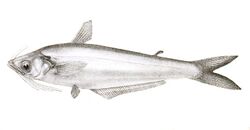Biology:Eutropiichthys vacha
From HandWiki
Short description: Species of fish
| Eutropiichthys vacha | |
|---|---|

| |
| Eutropiichthys vacha | |
| Scientific classification Error creating thumbnail: Unable to save thumbnail to destination
| |
| Domain: | Eukaryota |
| Kingdom: | Animalia |
| Phylum: | Chordata |
| Class: | Actinopterygii |
| Order: | Siluriformes |
| Family: | Schilbeidae |
| Genus: | Eutropiichthys |
| Species: | E. vacha
|
| Binomial name | |
| Eutropiichthys vacha Hamilton, 1822
| |
| Synonyms | |
| |
Eutropiichthys vacha is a species of schilbid catfish native to India , Nepal, Bhutan, and Bangladesh.[1][2] It can reach a length of 34 cm, and a mass of 1.35 kg. Eutropiichthys vacha is a climate sensitive species that may be selected as a target species for climate change impact studies. Region-specific adaptation was noticed in breeding phenology of this schilbid catfish in River Ganga, based on local trends of warming climate. A threshold water temperature around 24 °C and rainfall of > 100 mm were found to be necessary for attainment of breeding GSI (> 3.5 units) in E. vacha. It appears that warming climate may have the most profound effect on gonad maturation and spawning in E. vacha.[3]
References
- ↑ Bailly, N. (2015). Eutropiichthys vacha. In: Froese, R. and D. Pauly. Editors. (2015) FishBase. Accessed through: World Register of Marine Species at http://marinespecies.org/aphia.php?p=taxdetails&id=280759 on 2016-05-23
- ↑ Ng, H.H. 2010. Eutropiichthys vacha. In: IUCN 2014 . IUCN Red List of Threatened Species. Version 2014.1 .
- ↑ Sarkar, Uttam Kumar; Naskar, Malay; Srivastava, Pankaj Kumar; Roy, Koushik; Das Sarkar, Soma; Gupta, Sandipan; Bose, Arun Kumar; Nandy, Saurav Kumar et al. (2019). "Climato-environmental influence on breeding phenology of native catfishes in River Ganga and modeling species response to climatic variability for their conservation". International Journal of Biometeorology 63 (8): 991–1004. doi:10.1007/s00484-019-01703-3. PMID 31175418. Bibcode: 2019IJBm...63..991S.
Wikidata ☰ Q3753393 entry
 |

